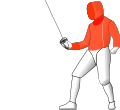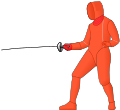
The following outline is provided as an overview of and topical guide to fencing, a family of combat sports using bladed weapons. Fencing is one of four sports which have been featured at every one of the modern Olympic Games.
Contents
- Fencing
- Types of fencing
- History of fencing
- Facilities
- Equipment and gear
- Weapons
- Other equipment or gear
- Bouting
- Officiating and rules enforcement
- Tactics and techniques
- Footwork
- Blade Work
- Fencing organizations
- Fencing clubs
- Fencing competitions
- Fencing publications
- Fiction
- Persons influential in fencing
- Other forms of fencing
- See also
- References
- External links



